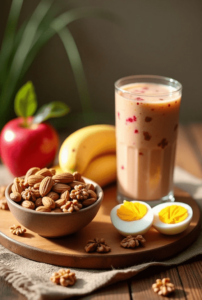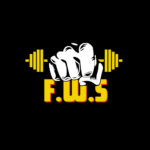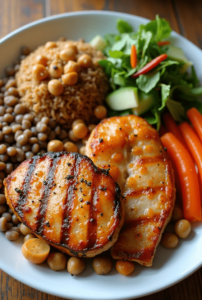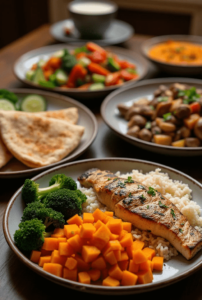Weekly Balanced Diet Chart for A Long-Term and Healthy Lifestyle!
Staying perfectly fit is not just about hitting the gym every day, it involves feeding your body excellent nutrition. If you want to gain muscle, lose fat, or live a long healthy lifestyle eating a well-balanced diet is key. Here in the article on the Balanced diet chart, we will guide you with making a 7-day Balanced diet chart and many more for optimal fitness, which suits your fitness path.
What is a Balanced Diet?
So, before we get into the details it is important to know what a balanced diet means, A proper diet supplies your body all the nutrients it needs to perform appropriately.
Eating a balanced diet means having a mix of many different foods in the right enough amount, so you get all the nutrition your body needs without eating too much of meals.
A balanced diet often includes:
Proteins: It is the main component in a balanced diet, required for muscle recovery and strengthening.
Carbs: Our body´s fuel. Carbs are mostly found in bread, rice, noodles, and oats
Fats: Provide an essential source of energy, help with hormone production, and are key in the absorption of vitamins.
Vitamins and Minerals: Essential for good health and body function and also boost the immune system.
Fiber: essential for digestion and a healthy gut.
Water: Hydration, and drinking enough water are necessary to make your body work properly and for overall body health.
Why does a balanced diet is important for fitness?
If you’re working out/exercising regularly, it is even more important to nourish your body with a varied combination of nutrients to support:
- Fuel your workouts
- Rest & Recover
- Help prevent nutrient deficiencies.
- Increase immunity
- Lower the risk of developing severe illnesses
Make sure you eat a mostly well-balanced diet that hits your macronutrient needs (carbs, protein, and fats) as well as provides enough micronutrients (vitamins & minerals).
Balanced Diet Chart for Week: How to Create It
Create a Diet chart, The very initial step to making a diet plan for weight loss is to think wisely about your fitness goals and learn what the bad options; sugary treats, processed snacks, fried foods as well high-sugar drinks like soda and fruit juices and also refined carbohydrates. No doubt that tastes might be good but you should avoid those unhealthy ones. Here’s a step-by-step guide:
-
Assess Your Caloric Needs
Designing a balanced diet chart: The first and foremost important thing that you need to do is describe your daily calories needed per average. Your age, gender, weight, height, and fitness level all play into the number of daily calories you require.
There are plenty of online tools to calculate your daily caloric requirements.
-
How to Calculate Your Macronutrient Profile
Step 2: After establishing how many calories you should eat in a day, The next step is to break down those daily calories among macronutrients (protein, carbohydrates, and fats).
A typical macronutrient ratio probably looks like this:
- Get 30% of calories from protein
- 50% of total calories; Carbohydrates
- Fats: 20 percent of total calories
Note: Protein Intake Based on Fitness Goals If you are bodybuilding like me for example- then yes more protein!
-
Stick to whole foods.
A great foundation for any meal is a large salad with veggies, store in different containers and occasionally add some pure lean protein and other forms of whole foods.
The goal was to have a GOLD standard diet mainly you should be eating whole foods in all meals. Wholegrain bread, fruits, vegetables and lean meat or other high-quality protein sources (e.g. legumes and nuts) are examples of this kind of food that give good nutrition i.e., rich in nutrients, supporting body composition, low-fat milk products such as yogurt.
Here is an example guide for you!
Breakfast
We all know how important breakfast is. But in the lands of the rising sun, breakfast can come in some really cute and charming forms. Breakfast: Of course, your most important meal of the day focus on balanced breakfast that combines protein and complex carbohydrates that get you started to have energy. Some examples include:
- Bowl of Oats with fruit + omelette
- A handful of nuts or pumpkin seeds with some natural Greek yogurt and fruit.
- An avocado toast and egg on whole grain bread for a nutrient-dense breakfast.
Lunch
For your lunch you would need to include protein, carbs and healthy fats. Think about it like this:
- Grilled chicken breast, lentils and steamed veggies.
- Mixed salad greens with chickpeas + grilled salmon, olive oil-based dressing.
Dinner
This is lighter than your lunch, however it should still be nutrient-dense. Some examples include:
- Baked Fish & a side of Sweet Potato with some steamed broccoli.
- Lean beef stir fry with peppers and mushrooms, served with brown rice.
- Lentil Curry with Roti and Cucumber Salad
Snacks
So, you need something to eat that is healthy between every meal. Options include:
- A few nuts of your choice (almonds or walnuts)
- A piece of fresh fruit (an apple or banana) with a tbsp of peanut butter.
- A protein shake or smoothie, boiled eggs & Sugar-free Whey Protein.

-
Mix Nutrient-Packed Foods
When creating a balanced diet plan, remember to include a variety of foods to ensure your body gets a broad range of vitamins and nutrients. Suggestions: High-nutrient foods for snacks
Proteins: Skinless poultry and lean cuts of beef, pork or lamb, tempeh & tofu (both soy products), fish high in omega-3 fatty acids or eggs; legumes such as black beans, garbanzo beans, and other peas.
Whole Grains: Brown rice, quinoa, oats, whole-wheat bread and barley
Fruits and Vegetables: All your favorite fruits, leafy greens vegetables.
Healthy fats: Avocados, nuts (almonds and cashews), seeds (chia, flaxseeds, etc.), olive oil, oily fish like salmon.
Dairy products: Greek yogurt, cottage cheese, and almond milk are also good options for snacking.
-
Weekly Balanced Diet Chart
Example of a balanced diet chart for a whole week;
Monday:
breakfast: Bread toast, Oatmeal with almond milk, chia seeds, and fresh berries alternatively.
Lunch: Grilled chicken salad containing mixed greens, avocado, cherry tomatoes olive oil dressing.
Snack: Greek yogurt, honey and walnuts
Dinner: Baked Salmon served with Quinoa and Steamed Asparagus.
Tuesday:
Breakfast: Whole-grain toast with mashed avocado, a poached egg, and an orange on the side.
Lunch: Brown Rice with Tofu stir fry containing Broccoli and Carrots.
Snack: So, my Tuesday snack is a banana with almond butter.
Dinner: Veggie burger in a lettuce bun with oven-roasted vegetables.
Wednesday:
Breakfast: Fruits and nuts bowl, banana protein smoothie with almond milk.
Lunch: Lentil soup + Whole grain bread and mixed green salad
Snack: A mix of nuts and a medium-sized apple.
Dinner: Grilled Shrimp with Sweet Potato Mash and Sautéed Spinach
Thursday:
Breakfast: Eggs, spinach, mushrooms, and whole-grain toast for a healthy breakfast.
Lunch: Quinoa bowl with black beans, corn, avocado, and salsas for taste.
Snack: Pieces of carrot and hummus.
Dinner: Grilled chicken breast + brown rice with salad.
Friday:
Breakfast: Plain Greek yogurt topped with a sprinkle of granola and a drizzle of honey, accompanied by some fresh fruit.
Lunch: Tuna salad with greens, cucumbers, olives and a whole-grain roll
Snack: 1 Dried Pineapple 2% Cottage Cheese and a few Chunks of Canned Pineapples
Dinner: Baked cod with cauliflower mashed potatoes and string beans
Saturday:
Breakfast: Whole-wheat pancakes with berries and scrambled eggs
Lunch: Turkey wrap made with whole-grain tortilla, lettuce, tomato, and avocado.
Snack: Protein bar and dark chocolate square
Dinner: Rice with baked tofu in spices.
Sunday:
Breakfast: Smoothie bowl with granola, coconut, and berries of the season
Lunch: Chicken Caesar salad (grilled) whole grain croutons.
Snack: Celery sticks with peanut butter
Dinner: A piece of grilled steak with sweet potato chips and a medley of greens.
-
Stay Hydrated
In a balanced, hydration is just one aspect that sometimes gets overlooked, but simply having enough water can be a lifesaver. Try to drink 8 glasses of water a day, more if you are active. This can also be in the form of herbal teas, coconut water, or other hydrating beverages.
-
Monitor and Adjust Your Diet
But remember, as things change and grow you may need to adapt your diet according to the signs from your body. If you are not able to notice some positive differences or even feel tired, be sure that you either revise your macronutrient combinations a bit or re-modify the size of the meal.
Final Thoughts of Balanced Diet
Create a Weekly Balanced Diet Chart for Your Fitness Goals. Making a diet chart for weight and fat loss is easier than you think! Focus on whole foods and superfoods that work for you. Remember:
– Consistency is key
– Listen to your body and adjust your plan
– Stay focused on your goals
– Eat whole and unprocessed foods that work for you
Check out the sample diet chart above and consult a nutritionist for personalized advice. With healthy food and regular exercise, you’ll be on your way to achieving your health goals!




